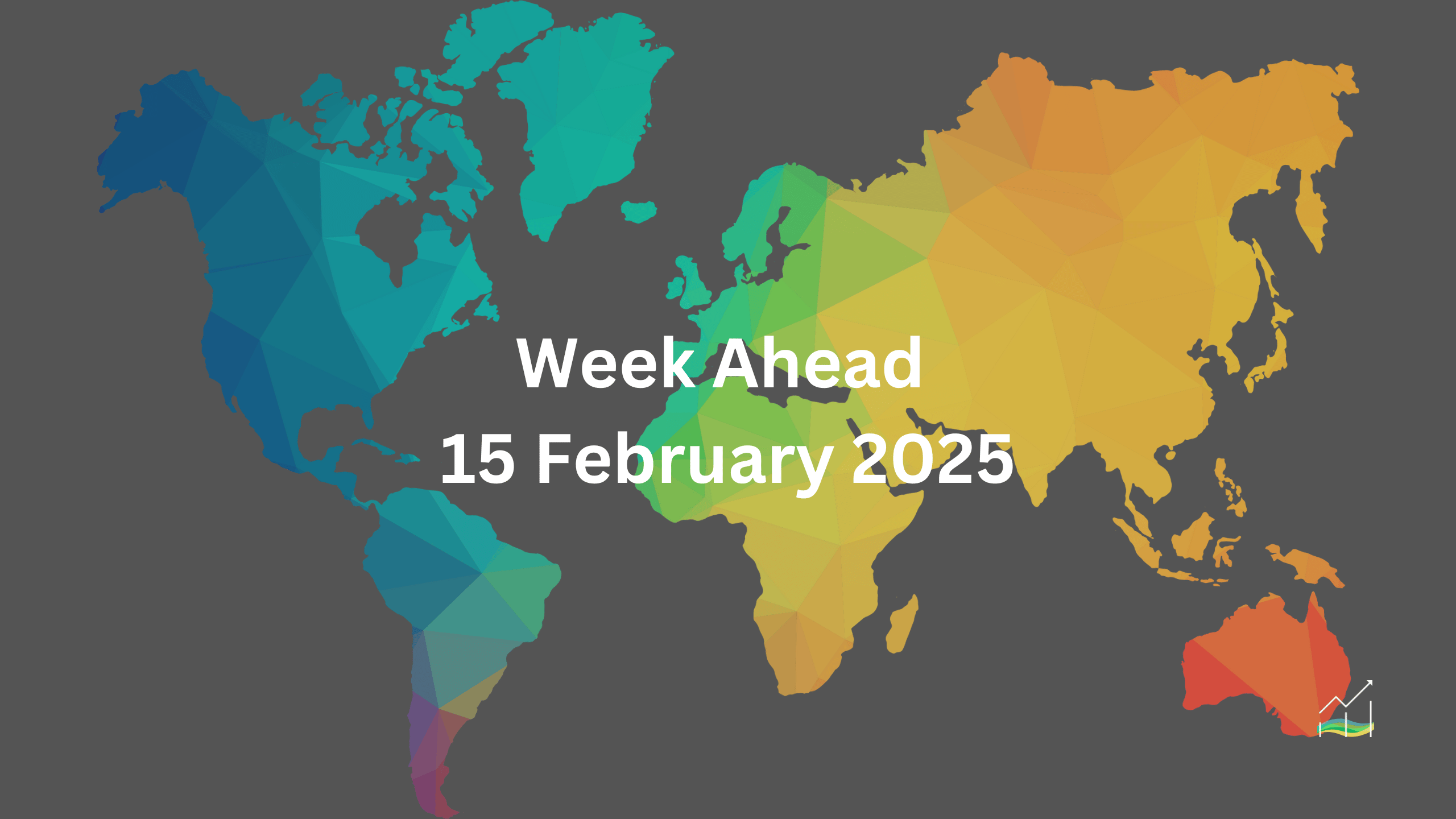15/02/2025 Week Ahead

Market Uncertainty Amid Trade Tariff Threats
The U.S. threat of aluminum and steel tariffs, along with potential reciprocal tariffs, initially unsettled markets. However, with implementation set for a future date, the move appears to be more of a negotiating tactic. During his first term, Trump converted some tariffs into quotas, which remains a likely outcome this time as well. Still, uncertainty lingers over U.S. trade policy and its broader strategy. Despite an upside surprise in U.S. CPI and PPI, markets largely dismissed the inflation data as noisy, with expectations that the Fed's preferred PCE measure may soften. U.S. rates declined last week, and the dollar weakened against all G10 currencies except the Japanese yen. While the dollar’s pullback seems more like a correction than a trend reversal, tariff concerns remain in focus.
Market participants lack conviction given the unpredictable nature of U.S. policy. The bilateral talks between the U.S. and Russia over Ukraine echo past geopolitical tensions, such as the Suez Crisis of 1956, where U.S. and European interests sharply diverged. As a result, U.S.-Europe relations appear to be at their most strained in decades. Looking ahead, the economic calendar is relatively light, with February’s preliminary PMI data standing out. Canada and the UK will release January CPI figures, while nine Federal Reserve officials are scheduled to speak.
Central banks in Australia and New Zealand could take diverging paths, with the Reserve Bank of Australia expected to start its easing cycle with a 25-basis-point rate cut, while the Reserve Bank of New Zealand is likely to continue its aggressive stance with a third consecutive 50-basis-point cut. The Federal Reserve’s January meeting minutes will be closely examined for any insight into the potential impact of new trade tariffs. Meanwhile, purchasing managers’ data from the U.S., eurozone, and UK may provide further evidence of the economic gap between the U.S. and weaker European economies. Japan’s upcoming economic growth report will also be a key focus in Asia.
United States of America
Overview
Two major forces are influencing the market: U.S. tariff threats and monetary policy uncertainty. While the Federal Reserve's next rate cut was fully priced in for July, recent economic data—including a second consecutive decline in unemployment, persistent inflation, and continued economic growth—has pushed expectations further out. Meanwhile, trade tensions remain a critical factor. U.S. multinationals, which play a key role in imports and foreign direct investment, could face disruptions if tariffs are imposed. Markets tend to buy the dollar when tariffs are threatened and sell it when the risk appears to be easing.
Economic Drivers
The Federal Reserve remains cautious about rate cuts despite recent inflation surprises. Chair Powell and Governor Waller have indicated that if economic conditions evolve as expected, rate reductions are still on the table. However, the Fed is also mindful of potential supply shocks from tariffs and their impact on inflation. The central bank has learned from the pandemic and will factor in trade policy risks when making decisions. Currently, Fed funds futures fully price in the next cut for October, with only a 50% chance of a second cut before year-end.
Despite higher-than-expected CPI and PPI figures, U.S. yields fell last week, marking the fifth straight weekly decline for the 10-year yield and the fourth in five weeks for the 2-year yield. Markets are adjusting positions as the so-called "Trump trade" struggles to gain traction.
Data and Events
This week features a full slate of economic reports, though none are expected to significantly shift Fed expectations. The key events include:
- Fed Meeting Minutes (Wednesday): Markets will analyze comments on inflation risks and potential tariff impacts.
- S&P Global PMIs (Friday, Feb. 21): Manufacturing and services data for February will provide insights into economic activity.
- University of Michigan Consumer Sentiment (Friday): Final consumer sentiment data for February will be released.
- Housing Data (Wednesday & Friday): January housing starts, permits, and existing home sales will be closely watched.
- Weekly Jobless Claims (Thursday): Labor market trends remain a focus.
- Treasury Auctions: $16 billion in 20-year bonds (Wednesday) and $9 billion in 30-year TIPS (Thursday).
- U.S. Markets Closed Monday: A public holiday will pause trading activity.
Markets will also keep an eye on any further comments from Trump regarding trade policies and developments in the Ukraine conflict.
Price Action
The Dollar Index dropped to a two-month low near 106.80, as long-dollar positions were trimmed due to disappointment over the effectiveness of tariff-driven strategies. The next technical support levels are 106.35, followed by the 104.90-105.15 range if the index breaks below 106.00.
Key Points:
- U.S. tariff threats continue to impact market sentiment, with traders buying the dollar on escalation and selling on de-escalation.
- The Fed remains patient on rate cuts despite inflation concerns, with markets fully pricing in the next move for October.
- Key data this week includes Fed minutes, PMIs, housing reports, and Treasury auctions.
- The Dollar Index has weakened, with technical support at 106.35 and further downside potential if 106.00 breaks.
Australia & New Zealand
Overview
The Australian dollar has been one of the hardest-hit currencies in the U.S. dollar’s broad rally since late September. It fell nearly 12.5% from a high of $0.6940 in late September to a low below $0.6090 in early February. While Australia maintains a modest trade surplus with the U.S., it has so far avoided direct trade tensions. However, monetary policy divergence is playing a significant role in the AUD’s weakness. The Reserve Bank of Australia (RBA) remains the only G10 central bank, apart from the Bank of Japan, that has not cut interest rates—but that is about to change.
Economic Drivers
The RBA is widely expected to cut rates for the first time since 2020, aligning with other central banks that have already eased monetary policy. Money markets are pricing in a 90% probability of a 25-basis-point (bp) rate cut, and all of Australia’s major banks expect an easing move. However, doubts remain due to strong labor market conditions, rising consumer spending, and inflation still slightly above target. Political factors may also influence the decision, with a federal election approaching and the ruling Labor government potentially seeking favorable economic conditions to boost re-election chances.
In contrast, the Reserve Bank of New Zealand (RBNZ) has been actively cutting rates. After reducing its official cash rate by 50 bps in each of its last two meetings, it is expected to deliver another 50-bp cut, bringing total easing since mid-2024 to 175 bps. With unemployment rising and economic growth contracting, the RBNZ is likely to maintain a dovish stance.
Data and Events
- RBA Meeting (Feb. 18): The most significant event of the week, with markets closely watching whether the central bank follows through with a widely expected rate cut.
- Employment Report & Preliminary PMI: Additional key indicators that could influence market sentiment.
- RBA Governor Bullock’s Testimony (Feb. 21): Will provide further insights into the central bank’s outlook.
- RBNZ Meeting (Feb. 19): Expected to deliver another rate cut, reinforcing its easing cycle.
- Wage Growth & Employment Data: Will offer further clarity on labor market conditions in Australia.
Price Action
The Australian dollar rebounded from its February 3 low of $0.6090 to $0.6370 before the weekend. It managed to break above the January high of $0.6330. The next resistance level is $0.6415, corresponding to the 38.2% Fibonacci retracement of its decline from $0.6940 to $0.6090. However, momentum indicators suggest the rally is nearing exhaustion. A close below $0.6330 could signal an early reversal.
Key Points:
- The Australian dollar has weakened sharply in the broader U.S. dollar rally but recently rebounded.
- The RBA is expected to cut rates for the first time since 2020, with a 90% chance of a 25-bp reduction.
- Strong employment and inflation figures create uncertainty around the RBA’s decision.
- The RBNZ is likely to cut rates again, continuing its aggressive easing cycle.
- Technical resistance for AUD/USD is at $0.6415, with a break below $0.6330 signaling a potential reversal.
Canada
Overview
The Canadian dollar has staged a strong recovery following the postponement of U.S. tariffs on Canadian imports. However, uncertainty remains, as the potential for hefty trade restrictions still looms. Meanwhile, investors are closely watching Canada’s upcoming inflation data, which will play a crucial role in shaping monetary policy expectations.
Economic Drivers
TD Securities has revised its interest rate forecast for the Bank of Canada (BoC), now expecting two rate cuts instead of three due to stronger economic data and hopes that Canada will avoid broad tariffs from the U.S. The BoC's policy outlook is now heavily influenced by trade risks and inflation trends.
The U.S.-Canada bond yield spreads have also narrowed slightly. The two-year yield spread between U.S. and Canadian bonds has fallen from 165 basis points (bp) to around 153 bp, while the 10-year premium has declined from a record high of 150 bp to about 137 bp. These shifts suggest that markets are adjusting expectations regarding monetary policy divergence between the two economies.
Data and Events
- Canada’s January CPI (Feb. 20): Inflation data will be crucial for the BoC’s rate path. In Q4 2024, inflation was flat on an annualized basis after declining 0.8% in Q3. The BoC’s core inflation measure averaged 2.45% in December, down from 3.35% in January 2024.
- December Retail Sales: Expected to rebound after a flat November, which was only propped up by auto sales. Without autos, retail sales declined 0.7% in November.
- Portfolio Flows: Foreign investment inflows averaged C$16.4 billion per month in the first 11 months of 2024, significantly higher than the C$2 billion monthly average in 2023.
- Housing Starts & Existing Home Sales: These reports are typically less impactful for the currency market but could provide additional insights into the health of Canada’s housing sector.
Price Action
The Canadian dollar has rebounded sharply from its February 3 low of CAD 1.48, when U.S. tariffs seemed imminent. The U.S. dollar has since declined 4.35% to trade near CAD 1.4150 ahead of the weekend, marking its lowest level since mid-December.
Technically, the CAD 1.4100 level represents a 50% retracement of the U.S. dollar’s rally from CAD 1.3420 in late September to the February high of CAD 1.48. However, the recovery may be nearing exhaustion, as momentum indicators suggest stretched conditions. If the U.S. dollar resumes its climb, resistance is expected around CAD 1.4260.
Key Points:
- Canada’s January CPI report will be the key focus for monetary policy expectations.
- The BoC is now expected to cut rates twice instead of three times, reflecting improved economic data.
- Trade risks remain, as potential tariffs on Canadian exports could impact inflation and growth.
- The Canadian dollar has rebounded 4.35% from its February low, but further gains may be limited.
- Key resistance for USD/CAD is at 1.4260, while support is near 1.4100 (50% retracement level).
China
Overview
Despite ongoing tariffs and trade restrictions, China appears to be benefiting from global disruptions triggered by the new U.S. administration. Tensions between the U.S. and key trade partners—including Mexico, Canada, and the EU—are escalating, while China continues to manage its economy and currency policy carefully. The People’s Bank of China (PBOC) is resisting downward pressure on the yuan, maintaining its commitment to currency stability amid external risks.
Economic Drivers
The U.S. administration’s aggressive trade stance has put renewed focus on China’s economic policies. Although U.S. tariffs on Chinese goods remain higher than China’s tariffs on U.S. imports, Beijing’s market interventions help mitigate volatility. Meanwhile, the property sector remains a key concern, with recent government support for struggling developers boosting sentiment. However, any optimism remains fragile, as weaker data could quickly reverse market confidence.
Monetary policy remains a balancing act for China. The PBOC has reiterated its commitment to easing but faces constraints due to trade uncertainties. Some economists argue that significant policy easing is necessary due to persistent deflationary pressures, while others believe the yuan’s stability will take priority over aggressive rate cuts.
Data and Events
- House Price Data (Wednesday): The property market remains under pressure, but recent signs of stabilization could provide relief. Any improvement in home prices would be a positive signal for markets.
- Loan Prime Rates (Thursday): The PBOC is expected to keep rates unchanged, maintaining its cautious stance. However, further easing could still be in the pipeline.
- January FX Settlements: These have been falling sequentially from December since 2020, despite previously seeing a seasonal rise in January before the pandemic.
- Yuan Management: Over the past week, the PBOC set the dollar’s reference rate between CNY7.1706 and CNY7.1719, reflecting efforts to keep the yuan stable.
Price Action
The offshore yuan (CNH) has strengthened in four of the past five weeks, despite trade frictions. The U.S. dollar ended the week near CNH7.25, with a January low of CNH7.2345 and a 200-day moving average near CNH7.22. This signals a level of resilience in the Chinese currency.
The PBOC’s approach to FX stability may limit the extent of monetary easing, as excessive rate cuts could weaken the yuan further. Goldman Sachs economists believe that while monetary easing is needed to counter deflation, the PBOC may prioritize currency stability given ongoing tariff uncertainties.
Key Points:
- China is seen as a relative beneficiary amid U.S. trade disruptions, despite tariffs and restrictions.
- The PBOC is actively managing yuan stability, resisting downward pressure from trade frictions.
- The housing market remains fragile, though recent government support has lifted sentiment.
- Loan prime rates are expected to stay unchanged, with further easing likely later.
- The yuan has strengthened in four of the past five weeks, with key technical levels near CNH7.22.
Europe
Overview
The euro faces pressure as the European Central Bank (ECB) is expected to cut rates further, likely before the Federal Reserve takes similar action. This policy divergence continues to weigh on the euro, with Europe facing significant geopolitical and economic challenges. Tensions with Russia, China, and now the US add to the uncertainty. The ongoing situation in Greenland and Europe's increased defense spending are likely to influence the supply of longer-term European debt. Meanwhile, the eurozone’s economy shows mixed signals, as key data points are set to be released.
Economic Drivers
- ECB's Rate Cuts: The ECB is anticipated to cut rates two more times before the Fed does, contributing to the euro's weakening.
- Geopolitical Challenges: Europe is still struggling to respond to Russia, China, and US pressures. France and Germany's proposed troop deployments in Greenland, although unclear in purpose, seem to be a reaction to US threats rather than Russian aggression or China's tactics.
- Defense and Debt: Increased defense spending in Europe, alongside peace talks between the US and Russia, could lead to more European debt supply.
Data and Events
- Trade and Current Account: With Q4 GDP already released, the upcoming December trade and current account data are not expected to make a significant impact on the markets.
- German ZEW & PMI: The Germany February ZEW economic sentiment index and preliminary February PMI will attract attention. The January IFO survey indicated a slight improvement in the overall business climate, although expectations weakened.
- European Tariffs: The EU's average tariff on US imports is about 3%, which is roughly double the average US tariff on EU imports.
- Upcoming Data: Germany will release its ZEW index and France will publish its final January CPI data on Tuesday. Eurozone consumer confidence surveys are due on Thursday.
- Bond Auctions: Germany will auction Schatz and Bund bonds, while Spain, France, Slovakia, and Finland have scheduled auctions.
Price Action
The euro rose to $1.0515 last week, driven by short covering. Although this marked the highest level for February, the euro has not closed above $1.06 since November 12. The $1.0550 region corresponds to a 38.2% retracement of the downtrend from late September. Despite this uptick, the euro's rise is seen as corrective rather than a trend reversal.
Key Points:
- ECB rate cuts expected to weigh on the euro.
- Europe faces growing challenges from Russia, China, and the US.
- Key German and French economic data set to be released.
- The euro's recent uptick is considered corrective, not a trend reversal.
- Upcoming bond auctions in several European countries.
Japan
Overview
The Japanese yen’s exchange rate is heavily influenced by two main factors: the US 10-year Treasury yield and speculation surrounding the Bank of Japan's (BOJ) interest rate hikes. The yen’s sensitivity to the US Treasury yield is greater than its correlation with the interest rate differential between Japan and the US. Currently, markets expect the BOJ to raise rates, with forecasts leaning toward July. As Japan's economy shows moderate recovery, several important data releases and events will help shape the outlook for the yen.
Economic Drivers
- US Treasury Yield: The yen is strongly correlated with movements in the US 10-year Treasury yield, impacting its exchange rate.
- BOJ Rate Hike Speculation: The yen is also sensitive to expectations about when the BOJ will increase interest rates. Market pricing suggests a 50% chance of a rate hike in June and 80% in July, with economists favoring the latter.
- Trade Deficit: Japan runs a trade deficit overall but maintains a surplus with the US, around $72 billion in 2023 and an estimated $63 billion in 2024.
- Inflation Pressures: Japan's CPI figures are showing firm price pressures, particularly in the Tokyo region.
Data and Events
- Q4 GDP: Japan’s Q4 GDP is expected to show growth of about 1.2% annualized, with consumption weak, inventories as a drag, but stronger business investment and net exports offsetting these factors.
- Inflation: The January CPI report is expected to show a slight rise in inflation, from 3.0% to 3.1%, with Tokyo data already signaling stronger price pressures.
- PMI Data: Japan’s preliminary February PMI is due, with a three-month rise in the composite PMI, though local markets tend not to react strongly to this data.
- Government Auctions: Japan’s Ministry of Finance will auction 1 trillion yen of 20-year JGBs, attracting interest from institutional investors due to higher yields on longer-dated bonds compared to shorter-term debt.
Price Action
The dollar initially rose to JPY154.80 after a stronger-than-expected US CPI, but fell back to nearly JPY152 due to declines in US rates and weaker retail sales. For the second week in a row, the dollar finished below its 200-day moving average of around JPY152.70. A break below the 4.40% US 10-year yield could push the dollar back below JPY152.
The low for USD/JPY in early December was near JPY148.65, and market movements suggest key levels to watch in the coming weeks.
Key Points:
- The yen is closely linked to US Treasury yields and speculation on the BOJ's rate hike timing.
- Market expectations point to a 50% chance of a BOJ rate hike in June and 80% in July, with July being the favored month.
- Japan's economy shows moderate recovery, with weaker consumption but stronger business investment and net exports.
- Inflation pressures in Japan are increasing, with CPI expected to rise to 3.1%.
- USD/JPY is facing key resistance at JPY152.70, with a potential test of JPY148.65 in the coming weeks.
- Japan's government is set to auction 1 trillion yen of 20-year JGBs.
United Kingdom
Overview
The UK has largely avoided being targeted by the Trump administration, but some speculate that the US might push for the UK to distance itself further from the EU. While Prime Minister Starmer has made better relations with the EU a key policy goal, the risk is that the UK government may fail to improve ties with both the US and the EU. Meanwhile, sterling’s movement against the dollar and the euro has shown a strong correlation of 0.80 over the past 60 days, with a peak in late January at 0.85. The UK economy showed modest growth in Q4 2024 despite earlier warnings of a contraction.
Economic Drivers
- Brexit and US-UK Relations: The ongoing situation between the US, the UK, and the EU remains a significant driver of the UK’s economic outlook, with potential policy shifts affecting market sentiment.
- Bank of England's Monetary Policy: Despite weak growth, the Bank of England (BOE) cut interest rates earlier this month and flagged further gradual cuts ahead. The swaps market expects another rate cut in May, but inflation and economic performance will be key to determining future rate decisions.
- Inflation and Consumer Confidence: Inflationary pressures are rising, driven by factors such as higher fuel prices and VAT on private school fees. This could affect the likelihood of another rate cut in March. Consumer confidence also remains a key concern, with potential knock-on effects from US trade policies.
- Employment and Retail Data: Employment figures and retail sales will be critical in assessing economic health, particularly in light of the BOE’s recent decisions.
Data and Events
- UK Economic Calendar: Important data releases this week include jobs data on Tuesday, CPI figures on Wednesday, and retail sales and public finance data on Friday.
- Purchasing Managers’ Index (PMI): The February PMI surveys for services and manufacturing are due. These could indicate whether trade tensions, particularly with the US, have affected investment and confidence.
- Producer Prices and Retail Sales: Producer prices, also due on Wednesday, alongside CPI data, will provide insights into inflationary pressures.
- Gilt Auctions: The UK plans to auction ultra-long October 2063 gilts on Tuesday and March 2028 gilts on Wednesday, important for gauging investor demand for UK debt.
Price Action
After a significant decline of around 10% from September to January, sterling has bounced back, hitting the 38.2% retracement level near $1.2610. The next target is the 50% retracement, which coincides with the 200-day moving average at $1.2765-90. The momentum indicators show signs of being stretched, indicating the potential for a pullback or consolidation.
Sterling has settled firmly, with the five- and 20-day moving averages trending higher, but further momentum may be limited given the stretched indicators.
Key Points:
- The UK is navigating complex relations with the US and the EU, with concerns over trade and future policy directions.
- The Bank of England’s monetary policy remains data-dependent, with market expectations for a rate cut in May.
- Inflationary pressures and weak growth are influencing the likelihood of further rate cuts in the short term.
- Key data points this week include jobs, CPI, retail sales, and PMI surveys.
- Sterling has recovered from a significant decline and is testing key retracement levels, but momentum may be slowing.
- The UK plans to auction long-term gilts, with investor interest key to understanding market sentiment.
© 2025 SKONE Enterprise (003319453-V). All rights reserved.
The content on this site is for informational purposes only and does not constitute financial advice.


